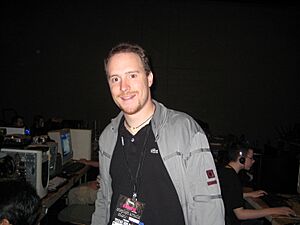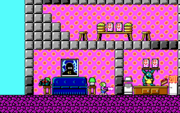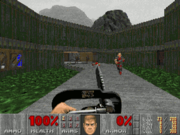- This page was last modified on 17 October 2025, at 10:18. Suggest an edit.
id Software facts for kids
This page is about the video game developer. For the geodata software editor, see iD (software).
 |
|
|
Formerly
|
id Software, Inc. (1991–2009) |
|---|---|
| Subsidiary | |
| Industry | Video games |
| Predecessor | Ideas from the Deep |
| Founded | February 1, 1991 in Shreveport, Louisiana, US |
| Founders |
|
| Headquarters |
,
US
|
|
Number of locations
|
2 (2024) |
|
Key people
|
|
| Products |
|
|
Number of employees
|
200+ (2016) |
| Parent | ZeniMax Media (2009–present) |
| Divisions | id Software Frankfurt |
id Software LLC is an American company that makes video games. It is based in Richardson, Texas. The company started on February 1, 1991. It was founded by four friends: John Carmack, John Romero, Tom Hall, and Adrian Carmack. They all worked together at a computer company called Softdisk.
id Software made big steps forward in video game technology. They created games for personal computers (PCs) like Wolfenstein, Doom, and Quake. Their work was especially important for 3D computer graphics and game engines. Game engines are the basic software that games are built on.
The company helped create the first-person shooter (FPS) game style. Wolfenstein 3D is often seen as the first true FPS game. Doom made this type of game and PC gaming very popular. Quake was id's first game that was fully 3D.
On June 24, 2009, a company called ZeniMax Media bought id Software. In 2015, id Software opened a second studio in Frankfurt, Germany.
Contents
History of id Software
How id Software Started
The founders of id Software – John Carmack, John Romero, and Tom Hall – first met at Softdisk in Shreveport, Louisiana. They made many games for Softdisk's monthly releases, including Dangerous Dave.
In September 1990, John Carmack found a clever way to make graphics scroll smoothly on a PC screen. This was a big deal at the time. Carmack and Hall used this new method to create a demo. It looked like the first level of the popular Nintendo game Super Mario Bros. 3. They used Romero's "Dangerous Dave" character instead of Mario.
When Romero saw this demo, he realized it had huge potential. The team worked extra hours to make a bigger demo of their PC Super Mario Bros. 3. They sent it to Nintendo. Nintendo was impressed but said they only wanted their games on their own systems.
Around the same time, Scott Miller from Apogee Software heard about the group. He contacted Romero. The Softdisk team then suggested ideas to Miller. One idea was Commander Keen, a side-scrolling game. It used the smooth scrolling technology from their Mario demo.
The first Commander Keen game, Commander Keen in Invasion of the Vorticons, came out in December 1990. It was a very successful shareware game. Shareware means you could try the first part of the game for free. If you liked it, you paid to get the rest.
After getting their first payment from Commander Keen, Romero, John Carmack, and Adrian Carmack (who was not related to John) decided to start their own company. They hired Tom Hall and finished the Commander Keen series. Then they hired Jay Wilbur and Kevin Cloud and started working on Wolfenstein 3D.
id Software officially began on February 1, 1991. The name "id" came from their earlier group, "Ideas from the Deep" (IFD). They dropped the "F" to make it "id". At first, they said "id" stood for "In Demand," but later they just liked "id" as a cool word. In September 1991, they moved to Madison, Wisconsin. Then, on April 1, 1992, they moved to Mesquite, Texas.
After Wolfenstein 3D became a big hit, id started making Doom. Tom Hall left the company. Sandy Petersen and Dave Taylor joined before Doom was released in December 1993.
Changes in the Team
Quake was released on June 22, 1996. It was a difficult game to make because the team had different ideas. This caused problems between John Carmack and John Romero. Romero left id Software after Quake came out.
Soon after, other team members also left. Sandy Petersen said in 2021 that the team needed a clear leader. He offered to lead, but John Carmack turned him down.
ZeniMax Media and Microsoft Ownership
On June 24, 2009, ZeniMax Media bought id Software. ZeniMax Media also owns Bethesda Softworks. This deal changed how id Software's games were published. For example, their game Rage was going to be published by Electronic Arts, but ZeniMax took over.
id Software moved from their office in Mesquite, Texas to Richardson, Texas in 2011.
On June 26, 2013, id Software's president, Todd Hollenshead, left the company after 17 years. On November 22, 2013, John Carmack, a co-founder and technical director, also left. He went to work full-time at Oculus VR, a company that makes virtual reality headsets. He was the last of the original founders to leave id Software.
In 2019, Tim Willits left the company. In March 2021, Microsoft bought ZeniMax Media. This made id Software part of Microsoft Gaming.
What "id" Means
The company writes its name with a lowercase id. It's pronounced like "did" or "kid." In the early days, the group called themselves "Ideas from the Deep." Later, they thought "id" stood for "in demand." But then someone suggested a link to Sigmund Freud's idea of the "id" in psychology. The others liked this idea. You can find a hint of this in the Wolfenstein 3D game instructions. It says, "that's id, as in the id, ego, and superego in the psyche."
Important People at id Software
- Kevin Cloud – He started as an artist in 1992. Since 2007, he has been an executive producer.
- Donna Jackson – She has been the office manager, often called the "id mom," since 1994.
- Marty Stratton – He joined in 1997. He is now the studio director.
- Hugo Martin – He became the creative director in 2013.
Former Important People
- Tom Hall – A co-founder and game designer. He left in 1993 after disagreements about Doom.
- John Romero – A co-founder and game designer. He left in 1996 after Quake. He then started his own company, Ion Storm.
- Adrian Carmack – A co-founder and artist. He left in 2005.
- John Carmack – A co-founder and technical director. He left in 2013 to work on virtual reality.
Game Development at id Software
Technology
id Software has always been known for its game technology. Starting with Commander Keen, they would license their game engine to other companies. A game engine is the basic software that makes a game run.
id Software created a new game engine for most of their big games. These include Commander Keen, Wolfenstein 3D, Doom, and Quake. After id Software used an engine for their own game, they would let other game developers use it too.
For many years, id Software's engines were very popular. However, their engine for Doom 3, called id Tech 4, was not used by as many companies as the Unreal Engine from Epic Games. This was because Doom 3 took a long time to make.
John Carmack believed in sharing source code. Source code is the basic instructions that make software work. He released most of id Software's major game engines for free under a special license. This means other people can use and change the code. Usually, the code was released five years after the engine came out.
Because of this, many people have used id's old code to make new projects. They have moved the games to different devices or added new features. For example, Wolfenstein 3D, Doom, and Quake can now run on many different platforms.
Since id Software released their engine id Tech 5, they call their engines "id Tech" followed by a version number. Older engines, like the Doom engine, are now called id Tech 1.
IMF Music Files
IMF stands for "id music file." It's an audio file format created by id Software for older sound cards. It's like MIDI because it stores musical notes, not recorded sounds. IMF files were used for music in early id Software games like Commander Keen and Wolfenstein 3D. Other companies also used this format.
Linux Gaming
id Software was one of the first companies to support Linux gaming. Linux is a different type of computer operating system. Many id Software games were made to run on Linux. These include Doom, Quake, Quake II, Quake III Arena, and Doom 3.
Because id Software released the source code for some of their older games, many other games that were not officially ported can also run on Linux. This is done using special programs called source ports.
Even though id Software no longer releases official Linux versions for all new games, they supported Stadia. Stadia was a cloud gaming service that ran on Linux servers. Also, games like Doom (2016) and Doom Eternal can be played on Linux using tools like Wine and Proton.
Games by id Software
Commander Keen Series
Commander Keen in Invasion of the Vorticons was a platform game. It was one of the first games for MS-DOS computers to have smooth horizontal scrolling. This game and its follow-ups made id Software successful as a shareware developer. This series is closely linked to game designer Tom Hall. The first Commander Keen trilogy came out on December 14, 1990.
Wolfenstein Series
id Software's big hit was Wolfenstein 3D, released on May 5, 1992. It was a first-person shooter (FPS) with smooth 3D graphics. This was new for computer games at the time. This game basically created a whole new type of game.
After Wolfenstein 3D, id Software made Doom, Doom II: Hell on Earth, Quake, and more. Each of these FPS games had better graphics. Wolfenstein 3D also led to other games in the series. These include Spear of Destiny and Return to Castle Wolfenstein. Newer Wolfenstein games like Wolfenstein: The New Order and Wolfenstein II: The New Colossus have also been released.
Doom Series
Eighteen months after Wolfenstein 3D, id Software released Doom on December 10, 1993. This game again set new standards for graphics and action in computer games. Doom had a sci-fi and horror setting. Its graphics were amazing for personal computers back then.
Doom became very popular. Its intense theme also led to discussions about violence in video games. Doom was released on many different game systems. It inspired many other games. It was followed by Doom II: Hell on Earth. id Software returned to the Doom theme in 2004 with Doom 3.
A new Doom game, Doom 2016, came out on May 13, 2016. It was released for Microsoft Windows, PlayStation 4, and Xbox One. It also came to Nintendo Switch in November 2017. In June 2018, the next game, Doom Eternal, was announced.
Quake Series
On June 22, 1996, Quake was released. This was another big moment for id Software. Quake used a new 3D engine, the Quake engine. It had unique art and graphics that were highly praised. The music was also special, created by Nine Inch Nails frontman Trent Reznor.
A key new feature of Quake was the ability to play "deathmatch" games online. This meant players could compete against each other over the Internet. This made Quake another huge success.
In 2008, id Software received an award for Quake because it allowed players to easily change and create their own content for the game. id Software is the only game company to win this award twice. They also won in 2007 for their 3D technology.
The Quake series continued with Quake II in 1997. This game had a new story about fighting aliens called the Strogg. Quake III Arena (1999) focused on multiplayer battles. Quake IV (2005) continued the story of the war against the Strogg. Some Quake games were made by other developers, not id Software directly.
There have also been other Quake games like Quake Live, which was a web-based version of Quake III.
Rage Series
In May 2007, id Software announced they were working on a brand new game series. It would use a new engine called id Tech 5. This would be the first game since Doom 3 (2004) to be made entirely by id Software in-house. Later that year, the new game's title was revealed as Rage.
Rage was released in October 2011. In May 2018, Bethesda Softworks announced Rage 2. This game was made by id Software and Avalanche Studios together.
Other Games
In its early days, id Software made many different types of games. These included early 3D first-person shooter experiments like Hovertank 3D and Catacomb 3D. They also made the Rescue Rover series and the Dangerous Dave series.
id Software also helped with games that used their technology but were not their own game series. Examples include Heretic and Hexen: Beyond Heretic.
Other Media
id Software has also published books based on their Doom games. They also helped with the Doom movie in 2005. In 2007, they announced a Return to Castle Wolfenstein movie was being made. A new Doom movie, Doom: Annihilation, was released in 2019, but id Software said they were not involved with it.
People Behind id Software
The book Masters of Doom tells the story of id Software. It focuses on the people and how they worked together, especially John Carmack and John Romero.
John Carmack
John Carmack is known for his amazing skills in 3D programming. He was id Software's main programmer from the start. On August 7, 2013, he joined Oculus VR, a company that makes virtual reality headsets. He left id Software on November 22, 2013.
John Romero
John Romero saw the smooth scrolling demo of Dangerous Dave and quickly thought of forming id Software. He helped start the idea of licensing game engines to other companies. John also worked closely with the Doom fan community. He helped create the way first-person shooter games are controlled. He also added "par times" to games like Wolfenstein 3D and Doom, which started the trend of "speedrunning" (trying to finish a game as fast as possible). Romero left id Software in 1996 and later started his own company, Ion Storm.
Tom Hall
Tom Hall was a designer who helped shape many important PC games in the 1990s. He was asked to leave id Software during the early making of Doom. However, he did have some impact, like adding teleporters to the game. He later worked for other game companies. Tom Hall has often said he would love to make another Commander Keen game if he could get the rights.
Sandy Petersen
Sandy Petersen was a level designer for many levels in the original Doom and Doom II. He was a fan of H.P. Lovecraft, and his ideas influenced the monsters in Quake. He left id Software during the making of Quake II.
American McGee
American McGee was a level designer for Doom II, Quake, and Quake II. He left id Software and later worked for Electronic Arts. There, he became well-known for creating his own game, American McGee's Alice. He later started his own independent game studio in China.
Images for kids
See also
 In Spanish: Id Software para niños
In Spanish: Id Software para niños








